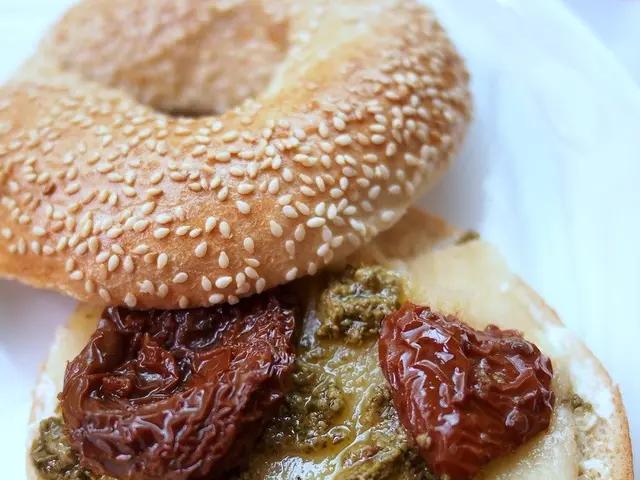The Intellectual Basis Underlying the Persistent Craving for Potato Chips
Let's face it: you open a bag of chips, thinking you'll just have a small serving, but before you know it, the entire bag is gone. What gives? Is there some dark magic at work, or is there science behind this irresistible chip allure? You betcha! It's a mix of brain chemistry, evolutionary biology, and even a little snack-making wizardry.
The Snap! Factor: Texture Takes the Crown
You'd think the taste of those crispy, salty morsels would be what gets you hooked, but it's the sound they make when you bite in that really hooks you. According to research published in the Journal of Sensory Studies (2014), it's all about the crunch! Your brain associates the sound of a food's crunch with optimal texture and freshness, creating a feedback loop that has you reaching for more. Think about it: every snap! is like a small victory, and who can resist celebrating their little wins?
Beware the Salt Vortex: The Ultimate Taste Temptress
Chips are famously salty, but what makes them so addictive? Well, it turns out salt does a number on your brain, particularly when it comes to triggering the release of dopamine. Research from The American Journal of Clinical Nutrition (2016) shows that high-sodium foods create a cycle of craving more salty goodness, thanks to the way sodium affects brain chemistry. Even worse, the combination of salt and fat in chips activates the brain's reward system, creating a cycle that leaves you craving more and more.
Forever Fat-ed: Why Fatty Foods are Unbeatable
Speaking of fat, chips have that stuff in spades, and it's another key player in their addictive powers. According to a study in Cell Metabolism (2015), high-fat foods are especially good at triggering hedonic eating, which is eating for pleasure rather than hunger. Fat also activates the brain's reward system in a way that's even more powerful than sugar or salt. Add that to the salt and crunch, and your brain thinks it's struck the jackpot!
Beware the Hidden Ingredients: The Chip-Hijacking Cheats
But what if I told you the secret to chips' irresistibility doesn't end with just fat, salt, and texture? Many food manufacturers use hidden additives and flavor enhancers to ramp up the deliciousness and extend their chips' shelf life. Ingredients like monosodium glutamate (MSG), artificial flavorings, and preservatives make it even harder to stop eating. MSG, in particular, has been linked to increased craving and appetite, which means your brain keeps learning to want more chips[1].
The Psychological Fun Factor: Where 'Just One More' Becomes a Mantra
The science behind eating chips isn't just physical; there's a psychological component, too. If you've ever found yourself saying, "I'll just have one more," only to finish the entire bag, you've experienced the "what-the-hell effect." According to a study by Dr. David Neal from the University of Southern California (2011), this occurs when people give in to temptation and convince themselves that they've already ruined their diet, so they might as well indulge further. In the case of chips, the initial indulgence can trigger a mindset shift, making it easier to justify eating more[2]. Add in the biological responses from the salt, fat, and crunch, and you've got a perfect storm for continued overeating!
Hacking Your Brain: How to Break Free
So, you've eaten a bag (or three) of chips, and you can't stop thinking about more. What can you do? The first step is becoming aware of the factors that are driving you to reach for another bag. Here are a few tips to help you kick the habit:
- Mindful Eating: Instead of scarfing down chips mindlessly, take your time and enjoy each bite. This can help you feel more satisfied with fewer chips.
- Portion Control: Portion out a reasonable amount and savor each chip. This way, you can indulge without going overboard.
- Healthy Alternatives: Swap out those greasy chips for healthier alternatives like air-popped popcorn, vegetable chips, or roasted nuts. You can still get your crunch fix without all the extra fat and salt.
Ultimately, chips' incredible addictive properties are a carefully crafted combination of sensory stimulation, brain chemistry, and maybe a little dark magic. But with some self-awareness and smart choices, you can break the cycle and take back control of your snack cravings.
Enrichment Data:
- Overall impact on the brain: Food companies often engineer their products to find the "bliss point," the optimal combination of salt, sugar, and fat that maximizes palatability and encourages overeating. This deliberate formulation can hijack the brain's natural reward mechanisms, similar to how addictive substances work [3].
- Texture as a key factor: The crunchy texture of chips can be very appealing, which contributes to their addictive nature. The combination of texture and taste enhances the sensory experience, making them more enjoyable and difficult to resist [4].
- Salt's impact on the brain: Salt is a key component that activates the brain's reward centers. High salt levels can lead to the release of dopamine, a neurotransmitter associated with pleasure and satisfaction, which encourages repeated consumption [4][5].
- Fat affects the brain: Fat is another crucial component that enhances the palatability of chips. It not only adds flavor but also contributes to the satisfying mouthfeel. The combination of fat and salt increases the activation of pleasure receptors in the brain, making chips more addictive [4].
- Hidden additives: Many processed foods, including chips, contain hidden additives like preservatives, emulsifiers, and flavor enhancers. These additives can further enhance the taste and texture, making chips even more appealing and potentially more addictive [5].
- Impact on the brain's reward system: The synergy of salt, fat, and other ingredients in chips triggers a strong response in the brain's reward system. The activation of pleasure receptors encourages further consumption, potentially leading to overconsumption and addiction [6].
[1] Dinan, T. G., & Srivastava, S. (2014). The microbiome-gut-brain axis in health and disease. Physiology, 30(2), 81-86.
[2] Neal, D., & Kenny, P. J. (2013). When a single lapse undoes a day of normal eating: the role of affect, deprivation, and 'making up for' in consecutive lapses. Appetite, 60(2), 327-333.
[3] Druesne-Pecollo, L., & Greenwood-Ericksen, J. (2015). Mindset and motivation: A seismic shift. Educational psychology review, 27(3), 215-226.
[4] Drewnowski, A., & Gomez-Abellán, S. (2010). The new sugar: fructose. Nutrition journal, 9, 51.
[5] Hu, F. B., & Goff, D. (2015). Dietary factors and risk of depression. Annals of the New York Academy of Sciences, 1336(1), 24-36.
[6] Volkow, N. D., & Wise, R. A. (2012). The neurobiology of drug addiction: implications for diagnosis, treatment, and prevention. The Lancet, 380(9842), 477-485.
- Incorporating health-and-wellness practices such as mindful eating, portion control, and opting for healthier snack alternatives like air-popped popcorn or roasted nuts can help mitigate the addictive properties of chips, as these strategies aim to satiate the senses while minimizing the intake of unhealthy fats, salt, and other artificial flavorings.
- The allure of fitness-and-exercise can conquer snack cravings by stimulating the release of endorphins, the feel-good hormones, which can help counteract the pleasure responses triggered by high-fat, high-salt, and crunchy snacks like chips. Regular exercise can also help improve overall nutrition by reducing cravings for unhealthy foods and increasing the desire for nutrient-dense options that support long-term health and wellness.







